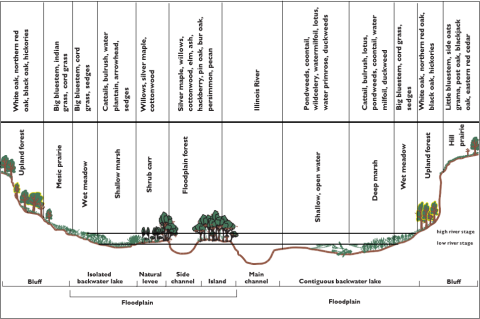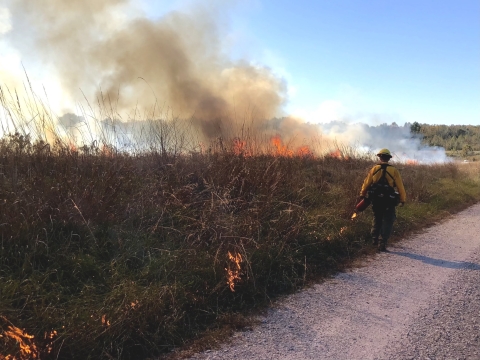What We Do
The National Wildlife Refuge System is a series of lands and waters owned and managed by the U.S. Fish and Wildlife Service. Wildlife conservation is at the heart of the refuge system. It drives everything we do from the purpose a refuge is established, to the recreational activities offered there, to the resource management tools we use. Selecting the right tools helps us ensure the survival of local plants and animals and helps fulfill the purpose of the refuge.
Refuges use a wide range of land management tools based on the best science available. Some refuges use prescribed fires to mimic natural fires that would have cleared old vegetation from the land helping native plants regenerate and local wildlife to thrive. Other refuges contain wilderness areas where land is largely managed in passively. The management tools used are aimed at ensuring a balanced conservation approach where both wildlife and people will benefit. At this field station our conservation toolbox includes moist soil management, prescribed fire and wetland restoration. These conservation tools are used to promote wetland-dependent plant communities and wildlife populations by mimicking the former natural system processes of the Illinois River Floodplain and by mitigating human caused landscape degradation.
Management and Conservation
The floodplains of the Illinois River are degraded by erosion, sedimentation and landscape modifications. Human modifications to the structure structure
Something temporarily or permanently constructed, built, or placed; and constructed of natural or manufactured parts including, but not limited to, a building, shed, cabin, porch, bridge, walkway, stair steps, sign, landing, platform, dock, rack, fence, telecommunication device, antennae, fish cleaning table, satellite dish/mount, or well head.
Learn more about structure of the floodplain, like navigation locks and dams, stream channelization, the diversion of Lake Michigan water, as well as agricultural levees, ditches and field tiles, have changed the floodplain function. With these changes have come changes in the diversity, abundance and general health of plant and animal communities.
Meredosia refuge is managed to mimic the historic flood cycle, a strategy which creates the conditions necessary to support native plant and animal communities that are reminiscent of a large river-floodplain ecosystem. Conservation tools are used to mitigate the human-induced changes to the flood cycle in order to promote biological diversity, stability and resilience in an altered system.
Moist Soil Management
Many refuge wetlands are equipped with water control structures that allow the manipulation of water levels. This manipulation permits us to control the summer drawdown of water levels and slowing increase water levels during seasonal flooding.
When mud flats are exposed by summer drawdowns, moist soil plants develop. These plants have the potential to produce high seed yields that serve as an important food source for waterfowl and other wildlife. Compared with grain from agricultural fields, moist soil plants contain a better balance of nutrients. Water levels are slowly increased in the fall to provide the desired mix of open water and mature flooded moist soil vegetation.
A prescribed burn is the controlled use of fire to restore wildlife habitat, reduce wildfire risk, or achieve other habitat management goals. We have been using prescribed burn techniques to improve species habitat since the 1930s.
Learn more about prescribed burn of a grassland unit. | Image Details
Prescribed Fire
Fire is a natural and cultural part of the North American landscape and is an import tool in maintaining refuge prairies, wooded areas and wetlands.
For thousands of years, the landscape was subject to regular fires, caused by lightning or used as a hunting tool by Native Americans. Today, fire management staff initiate controlled fires in fire dependent habitats to mimic the role of fire in maintaining open habitats. Fire keeps prairies and wetlands open by setting back encroaching shrubs and trees, exposes soil for native seeds, removes vegetation build up. and stimulates the growth of some plants.
Wetland Restoration
Restoring wetlands is often simply a matter of destroying manmade drainage facilities and letting water and vegetation return to the site naturally. The same tools used to destroy wetlands are used to restore them. If a wetland is drained by underground tile, a section of the tile is uncovered, removed and the area is backfilled with soil. Wetlands that are drained by ditches are restored by the construction of an earthen ditch plug at the outlet to the wetland. A pipe or earthen spillway is used to regulate water levels and provide for overflow. On larger wetlands, a water control structure may be installed that allows a periodic drawdown of the wetland to mimic the natural wet-dry cycle of many basins.
After restoration, wetland plants begin to reappear. The seeds of some wetland species can lie dormant, but viable, for as long as 30 years, as they wait for moist conditions to return. These species will be among the first to appear after restoration, often even after years of agricultural herbicide use. Other seeds are carried into the wetland basin by birds, wind and floods. It is generally not worth the cost to attempt to revegetate a large wetland; if the conditions are right for a species, it will find its own way into the restored basin.
If you are interested in restoring a wetland on your property, contact the refuge to learn about the Partners for Fish and Wildlife program.
Law Enforcement
U.S. Fish and Wildlife Service law enforcement officers have a wide variety of duties and responsibilities. Officers help visitors understand and obey wildlife protection laws. They work closely with state and local government offices to enforce federal, state and refuge hunting regulations that protect migratory birds and other game species from illegal take and preserve legitimate hunting opportunities.
Laws and Regulations
All land and water areas of the refuge are open daily from sunrise to sunset, from February 1 to October 15. From October 16 through January 31, refuge lands west of Meredosia Lake are closed to provide a safe resting place for migratory birds. Please see the Rules & Policy page for refuge specific regulations.



